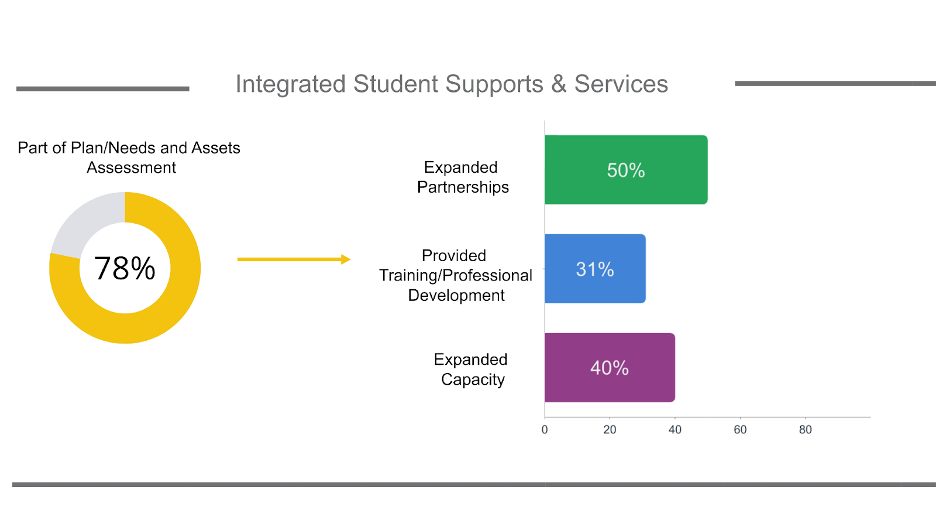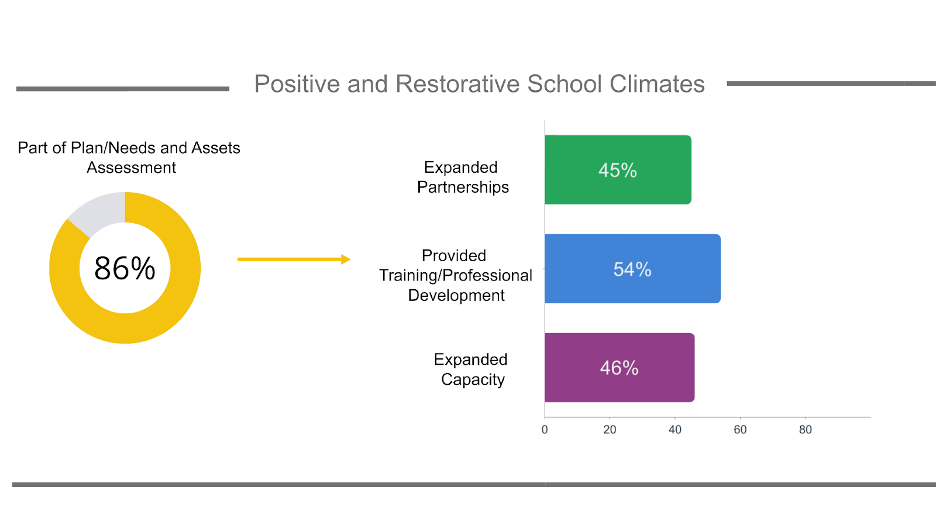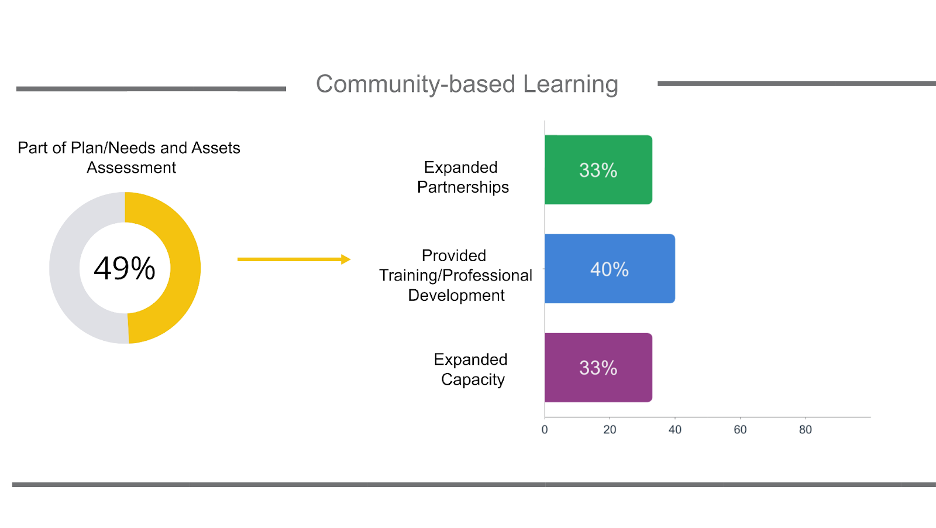In 2021, in a landmark move fueled by the efforts of advocacy and community organizing, the California Legislature ushered in a new era of educational transformation with the passage of the California Community Schools Partnership Program (CCSPP). With an allocation of $4.1 billion, this historic initiative aims to establish, strengthen and expand community schools across the state, with a focus on schools and communities with demonstrated need. This investment underscores the state’s unwavering dedication to the principles of community schools—an age-old concept that serves as a vital bridge between schools and the communities they serve. By embracing a holistic approach that prioritizes academics, health and social services, the CCSPP, as outlined in the California Community Schools Framework, seeks to reimagine and transform schools into inclusive, racially just, and relationship-centered environments that prepare all youth for positive social and emotional development, engaged citizenship, and deep learning.
In May 2022, the first round of CCSPP grants were awarded. A total of 192 Local Educational Agencies (LEAs)—primarily districts—were provided planning grants, while an additional 76 LEAs (supporting 458 schools) were awarded implementation grants to expand and sustain their efforts. Since then, the momentum has continued to build. A second cohort of planning and implementation grantees were provided awards by the California Department of Education in May 2023, and a third cohort of implementation grantees is expected to be announced in May 2024.
This is the first post of a blog series dedicated to sharing insights from CCSPP grantees across California. We will shed light on CCSPP successes, areas of growth, and the impactful changes and outcomes experienced by young people, families, educators, and local communities. From innovative approaches to curriculum development to community partnerships that foster student learning and well-being, we’ll share the many ways in which community schools are reshaping the educational landscape.
The initial posts in this series will delve into the findings of the state’s Annual Progress Report (APR)—a valuable reflective and learning tool that was provided to all Cohort 1 CCSPP grantees for the first time in fall of 2023. In particular, we provide a first glance at the progress of approximately 450 schools that are supported through CCSPP implementation grants to transform to community schools.
Who responded to the APR?
According to an analysis of Cohort 1 grantees, conducted by the Opportunity Institute, CCSPP grant applicants—both planning and/or implementation—were represented across the state. LEAs in more than three-quarters of the state’s counties submitted CCSPP grant applications. Based on their analysis, grants were awarded to schools that serve a high concentration of students with the greatest needs. Ninety percent of students who are enrolled in schools that received implementation grants in Cohort 1 were either low-income, English learners, or foster youth (compared to a statewide average of 63% for these populations). This aligns with the state’s goal of prioritizing schools that serve students with the highest level of need through the CCSPP. Implementation grants also appear to be benefitting a disproportionately large share of African American (8%) and Latino/a/x students (74%) as compared to statewide averages for both groups. Ninety-six percent of all schools responded to the APR.
What are we learning?
As part of the APR, schools were asked to reflect on their offerings of a range of whole child and family supports that are aimed to ready and advance students’ classroom learning (for example, engaging curriculum like project-based learning, after school programming, health screenings, mental health services, social-emotional skill development, etc.). Schools indicated if the support was identified as part of a comprehensive needs and assets assessment (NAA) of their local community that is conducted by community schools and/or was included in their implementation plan. Grantees then shared if they had engaged with or expanded partnerships, provided training or professional development to improve delivery, and expanded their capacity to offer the support during the grant period, among other response options.
In this first post, we highlight how schools are: 1) integrating a range of supports and services into their community schools vision; 2) committed to creating positive and restorative school climates; and 3) working to enrich their curriculum to provide students’ with engaging learning opportunities.
Integrated Student Supports & Services
Community schools recognize that students’ success in the classroom is deeply interconnected with their overall well-being. By responding to the diverse and holistic needs of students, community schools create a support system that fosters academic achievement and overall positive development. When students feel supported and cared for, they are more engaged in their learning, prepared for classroom success, better equipped to handle challenges, and empowered to reach their full potential.

Responses to the APR demonstrate that schools acknowledge this interconnectedness. For example, schools identified the provision of health (80% of schools) and mental health screenings (87%), additional academic support like tutoring (86%), nutritional services (76%) and a multi-tiered system of support that ensures coordination of services (86%) as part of their community schools implementation plan based on the needs of their community. Half of these grantees that identified integrated student support and services as part of their plan or NAA, expanded their partnerships and 40% expanded their capacity to offer these supports. In their first year of implementation of the grant, close to a third of these schools provided training or professional development to support and improve the delivery of these supports and services. As the mental health of our young people has grown steadily worse for more than a decade, with the COVID-19 pandemic exacerbating the trend, we note that 59% of schools that had mental health provision as part of their implementation plan or NAA expanded their partnerships to provide mental health services, and 50% expanded their capacity to provide these supports.
According to the APR response of one CCSPP grantee, “…Our chronically absent[ee rate] decreased by 15.6%… This decrease is a direct result of our partnership with [name of health provider]. On average, 87% of students that visit a…provider here at school are able to return to class. Through strategic partnerships, we have been able to provide comprehensive health services to students, ensuring timely medical attention without compromising their academic commitments. The telehealth initiative has effectively broken down barriers to healthcare, especially for families facing geographical or financial constraints.” A second grantee shared, “[Our collaboration has] been pivotal in expanding the range of healthcare services offered. The medical group’s expertise has not only addressed immediate health concerns but has also facilitated preventive measures, contributing to a healthier and more engaged student body. Regular health check-ups, vaccinations, and future health education programs have become integral components of the community schools’ holistic approach to nurturing the overall well-being of students.”
Positive and Restorative School Climates
Based on what we know from the emerging science of learning and development, California community schools strive to provide the supportive environmental conditions that enable students to better engage in learning and cognitive processes. Through relationship-centered spaces, trust, connections, and social-emotional skill development, community schools aim to create an environment that promotes optimal learning and development.

According to APR responses, 86% of all schools worked to establish positive and restorative school climates where students and families feel a sense of belonging and purpose, welcome, safe and supported. These schools, for example, indicated that the provision of positive behavioral supports, restorative practices, and social-emotional skill development that aim to enhance students’ behavioral, academic, social and emotional growth were part of their community schools plan or needs and assets assessment.
Forty-five percent of schools that identified positive and restorative school climates as part of their plan or NAA indicated that their CCSPP grant enabled them to engage and expand their partnerships to create a positive school climate, and 46% expanded their capacity to do so. Importantly, 54% of schools indicated that they were providing educators with training or professional learning in these areas. For example, a CCSPP grantee shared, “The partnership with [name of partner] is significant for our community schools work because we are seeking to train our administrators, teachers and other staff in restorative practices and conflict resolution. By June of 2023, the [name of partner] had helped…our schools develop peer mediation programs, had offered training in community circle practice and peer mediation district wide, and had supported the implementation of community circles…”
Community-Based Learning
CCSPP grantees also shared that connecting the community schools strategy to classroom practice was an area of growth. California community schools seek to engage students in deep learning opportunities that bolster classroom-community connections through powerful instruction that is student-centered. Classrooms and learning spaces draw from the rich assets of students, families and educators—building on their diverse histories, cultures and their full linguistic repertoires—to engage students in learning that is relevant, contextual, culturally-responsive, and cultivates young people’s agency to be competent, productive and active participants in their communities.
In the first year of implementation, fewer schools indicated expansion of community-based learning practices compared to offerings aimed to strengthen integrated student supports and school climate. Yet, almost half of participating community schools indicated that the provision of these engaging learning strategies (e.g., project-based learning, Youth Participatory Action Research, personalized learning plans, performance assessments, etc.) were part of their community schools plan or needs and assets assessment. Schools were particularly focused on the provision of culturally sustaining and responsive curriculum and pedagogy, with approximately two-thirds of schools indicating that these practices were part of their implementation plan or needs and assets assessment. One grantee shared how their students engaged in Youth Participatory Action Research (YPAR) that connected students’ classroom learning to their communities. According to data provided in their APR, “[YPAR] projects culminated in a presentation to inform the school board of the issues our student researchers explored and the progress they made to improve the health of their school environment…Over the course of the school year, each student researcher dedicated an average of 27 hours towards their research project and, altogether, invested 192 hours towards improving the health of their school environment.”

Forty percent of first round CCSPP grantees that identified community-based learning as part of their plan or NAA, one year into implementation, indicated that they were providing critical training and professional development focused on the delivery of these learning strategies. A third of these schools also indicated that they had engaged or expanded their partnerships aimed to support community-based learning opportunities, and that they had expanded their capacity to offer these learning opportunities to their students.
What’s next?
CCSPP stands as a landmark investment in the future of public education in California. Through this blog series, we aim to shed light on the progress of CCSPP grantees so that we—practitioners, policymakers, researchers, students, families and partners—can track, shape, and advocate for the continuous efforts of grantees to transform their schools to nurturing, inclusive and welcoming spaces that inspire curiosity, ignite imagination, deep learning and can promise our young people with the bright futures they deserve.
In our inaugural post, we delved into the insights derived from CCSPP grantees’ first-year journey of implementation as documented in the Annual Progress Report. Our focus was on the provision of comprehensive supports and services that nurture the whole child and their family, recognizing the critical link between learning and addressing students’ social, emotional, cognitive, and physical needs. In subsequent posts, we’ll explore grantees’ reflections on student, family, and community engagement, implementation strategies, and grantees’ progress toward identified goals.
As lawmakers work on developing the 2024-25 state budget, it is important to keep in mind that the investment in CCSPP is still in the initial stages of implementation. These data suggest that grantees are developing and expanding a range of whole child supports and services, with exciting work ahead mapped out in their local implementation plans and needs and assets assessments. Steady funding will be essential to ensure the resources are in place to bring these plans to fruition.
As we wrap up this initial post, we spotlight a CCSPP grantee’s reflections on their journey thus far. In their own words:
“We are immensely proud of our ability to offer comprehensive support to thousands of families, thanks to our collaboration with outstanding local organizations… Our partners’ dedication has created a safe space where parents feel empowered to seek assistance and break down barriers to accessing vital support services.”

